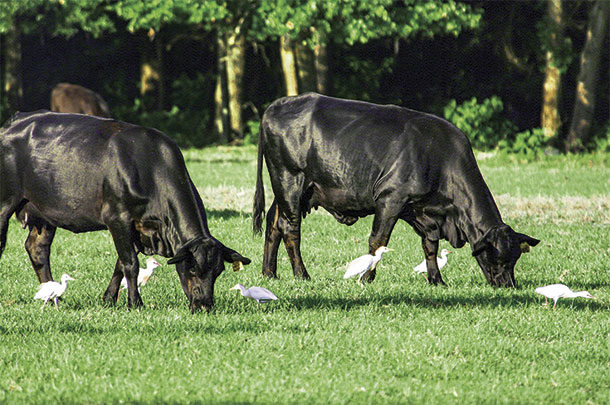Deworming calves can add 10 to 20 pounds at weaning, increase female milk production and increase body condition score. However, for every parasite in the animal, there are thousands of infective larvae on the pasture.
Pastures harbor most of the potential parasite load, and pasture management is an integral part of a complete parasite management plan. You can deworm the cow and kill the adult worms but, as soon as she grazes, she is ingesting larvae that start the process over again.
Internal parasite cycle
Although there are many different types of internal parasites that infect cattle, most of them share the same basic life cycle and are dependent on favorable environmental conditions:
1. Female parasites lay eggs in the animal’s digestive system that are passed along with the feces.
2. Eggs hatch in the fecal pat and consume organic matter while molting into the L2 and L3 (more mature) stages of growth.
3. L3 larvae do not eat but migrate out of the fecal pat and up grass blades to be ingested by grazing animals.
4. After consumption, the L3 larvae find the appropriate organ, burrow into the lining and molt to a final adult stage that is ready to reproduce.
Adequate temperatures and moisture are needed for the larvae to molt between stages. However, some eggs cans survive for years in the soil or in the pasture, and some larvae in the animal can enter a hibernation (hypobiosis) stage while waiting for environmental conditions to be adequate. Moisture is necessary for the larvae to exit the fecal pat and climb up the blade of grass. This means the timing of parasite control is dependent on the herd and the location.
Grazing management
In order to manage grazing, ranchers need to understand how cattle graze. Research shows that cattle graze primarily in the early morning and late evening, will avoid fecal deposits and are selective. This means they are grazing during the same time larvae are migrating but will avoid contaminated areas if there is enough forage available. If forage is sufficient and water is easily accessible, cattle will not revisit a grazed area for several weeks.
Providing a rest period through rotational or mob grazing can reduce the internal parasite load on the pasture in two ways. Most importantly, it increases the utilization and nutritional quality of forages, producing heavier cattle with a higher body condition score. Animals on a higher nutritive plane can handle parasite burdens much more efficiently than animals in poor condition.
Second, it provides a rest period where animals are not available to ingest the larvae or spread more to the pasture. The length of the rest period will depend on the weather and location of the ranch and can range from three to four weeks in hot and dry conditions to four to six months if the environment is humid and warm. Once the larvae hatch and the weather is favorable, they will begin to migrate. If they aren’t consumed in time, and the weather changes, they will die.
Cattle will develop a natural resistance to internal parasites, but this takes roughly two grazing seasons to be effective. Calves are the most susceptible to parasite burdens and, to mitigate this, ranchers can creep graze calves ahead of the cows or graze pairs on pastures that were not grazed for a season. Creep grazing allows calves to graze ahead of the cows that are shedding eggs and fill up on uninfected forage, while seasonal breaks provide a sufficient time for eggs and larvae to be killed in the pasture. Grazing hay fields is also considered a safe practice, since the pasture has been rested and the hay harvested will be safe, as larvae cannot survive the drying process.
Pasture management
Pasture management is arguably one of the easiest strategies to reduce parasite loads and, paired with herd health and grazing management, gives ranchers a great opportunity to reduce anthelmintic use if needed. Managing stocking rates decreases overgrazing and patch grazing and allows animals to be selective and stay away from fecal pats. Larvae cannot travel very far, and maintaining forage height also reduces ingestion rates.
There are also several mechanical methods of pasture management to help ranchers decrease parasite loads. Dragging during hot and dry weather exposes the eggs and larvae to heat and dries them out. Harrowing and discing can bury parasites and inhibit their ability to infect forage. Burning removes parasites, as it removes grass, thatch and fecal pats.
Summary
Anthelmintics have been the stable of internal parasite control in cattle, but resistance is developing and currently there aren’t additional chemical control options. Ranchers can increase the effectiveness of their parasite management plans by incorporating grazing strategies that break the parasite cycle, provide a safe forage source for young and susceptible animals, and decrease the parasite load and therefore decrease the reinfestation rates of cattle. Grazing, pasture and herd health management are all components of an integrated pest management plan to decrease the internal parasite burden in cattle and increase profit. ![]()
PHOTO: Cattle graze bahia pasture in Florida. Photo provided by Eric Zamora, UF/IFAS.

-
Jane Cant
- Agriculture Extension Agent
- University of Florida Extension
- Email Jane Cant







